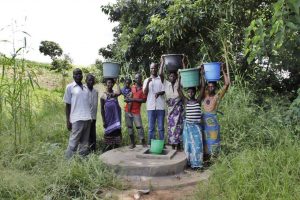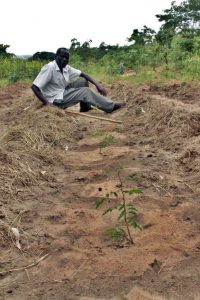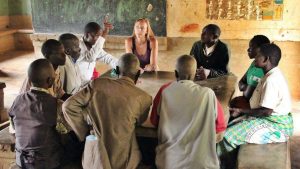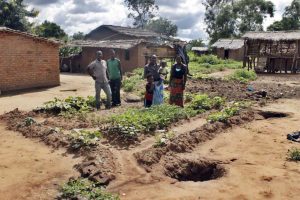This project has been completed under the direction of Peace Corps Volunteer Amanda Larson.
The project was designed to build three new wells, install 13 rainwater harvesting systems, and irrigate a number of community gardens.
To read about the beginning of the project, CLICK HERE.
Amanda reports as follows:
Specific Work and Goals Achieved:
The main goal of “introducing a new water technology in their communities to sustain household permagardens and tree nurseries” has been achieved through the introduction of 3 newly dug wells in 3 villages, as well as newly installed rainwater catchment systems and 1000 L tanks in 13 homes across 6 villages.The 3 wells were dug in 3 out of the 6 villages – we chose the villages with the highest population/need: Kamsonga, N’Gombe, and Mteya Villages. They were hand dug by 3 men – using their metal tools and switching in and out among the 3 of them. We dug them at the height of dry season so that they would not be dug to shallow creating them to hopefully always have plenty of water. We dug all 3 of them to a depth of 30 meters. They are all lined with mud brick, which was a community contribution.
We also created a nice cement foundation above ground – also a community contribution. The water is currently being drawn by ropes and buckets that are dropped down. The SOLID group is going to create another IGA project, and apply to another grant to hopefully purchase well pumps. These wells were created to be for agricultural use – permagardens, fields, and tree nurseries.
The tanks are commercial 1,000 liter tanks that were purchased in Lilongwe, and transported to Kamsonga by a rented truck. We bought PVC piping, and a plastic gutter that make up our gutters that are hung by wire from the roofs. The full PVC piping is what funnels the water from the gutters into the water tank. Once the tanks are empty, and before rainy season, they will simply need to be cleaned.
We will not be needing to purify the water as the water should not be used for household necessities. It is meant to sustain their permagardens and tree nurseries during the dry season.
The End Result:
The rains began to embark upon Ntchisi District in December of 2015. The 13 members planted their nurseries, and then received their 1000 L tanks. Christmas is often not celebrated in the village quite to the extravagance as the rest of the world does it, but the day those tanks arrived it felt like Christmas had come to Kamsonga. There was so much joy, singing, and celebration. Amanda’s counterpart, Lawrence Chiwaya, was Santa Claus, and she was his little elf.As the month progressed, everyone established the systems in their homes and began to collect rainwater. One home even collected all 1000 L after one particularly heavy rain. After everyone concluded planting in their fields, the last step began: the establishment of the gardens. This is where the story currently is for now. It will take some time to evaluate the project as a whole, in order to measure the impact on nutrition and forestation, but the rainwater systems themselves are proving to be quite successful at their task of collecting water this rainy season, and rainy season is still only at the beginning.
SOLID members have built their capacity regarding grassroot development as an entirety. Before I came to Kamsonga, the members had never heard of “sustainable development” nor realized the importance of doing development work on their own. They now have an understanding of what skills are necessary to do development work, and how to implement the skills. Implementing this project was the practical for the entire SOLID training: from designing the project, creating an action plan and assigning tasks, writing out a budget, to finding a funding source, writing and applying for a grant, and implementing the project. It is not common for a group comprised of subsistence farmers to go through this entire process, and the skills they have been able to attain during this process will leave a lasting impact on them and their community.
There have been many skills developed through the two-year process leading up to the implementation of this project: community assessment skills, project design and management skills, writing skills, computer skills, professional skills, business skills, tree nursery establishment/management skills, water management skills, as well as permagarden implementation and management skills.
The Sustainability of the Project:
SOLID Volunteers have the knowledge needed to sustain the activities within their communities because that is what they have been trained in in the SOLID program, and that is their goal in all projects being conducted. SOLID members are continuing their peanut butter IGA in order to use this money to support the maintenance of this project, as well to expand from this project. The sustainability of an IGA is an important step in the design of any project that does not solely depend on freely accessed, local natural resourcesIncluding the important connections, the Kamsonga community has with these parties, SOLID members have also learned how to access their own sources to submit proposals for future project funding. If someone in the community is interested in accessing funds to help with this project, SOLID members will have the skills and the knowledge needed to help the community member apply for funds.
Quote:
“Sister, because of you, I have learned so much and do not fear you leaving because I know that as a SOLID Group we will continue, and the project will also continue.” – Mr. Lawrence Chiwaya
We are grateful to Amanda for completing this excellent project.



